Posted on 03/18/2003 9:33:33 AM PST by blam
Heavenly bodies stir up routine catastrophes
March 18 2003 at 01:30PM
By Graeme Addison
Legend has it that when two people get together and er... bond, the Earth will move – at least in a metaphorical sense. Likewise, it takes two heavenly bodies, an impactor and a target, to come together with Earth-shattering force to form a crater. There’s nothing dreamlike about this: it happens, frequently, throughout the solar system. Impact catastrophes are routine.
Just over two-billion years ago, a chunk of asteroid at least the size of Table Mountain struck the landmass that is now South Africa. It hurtled in at a speed in excess of 55 000km/h, or about 160 times the speed of Shumacher’s Ferrari in full cry.
Welcome to the realm of cosmic uncertainty and sudden impacts. More specifically, an impact that changed the face of primeval South Africa. The world-famous Vredefort Dome – centred on a tiny northern Free State dorp and now billed as the oldest and biggest asteroid impact site on the planet – was finally accepted as a blast site by the majority of scientists only in the mid-1990s. It is now being proposed as a World Heritage Site (South Africa’s fifth, after Lake St Lucia, Robben Island, Sterkfontein Caves and the Drakensberg). Although a great deal is now known about crater formation, much remains speculative
Despite its obvious significance, there is still much speculation about Vredefort. Today leading geologists are disputing whether the impactor set the Earth’s crust on edge or not – whether there is a shear zone as if a mighty fist had punched a hole in the crust, leaving shards of it standing upright. Yes, say the crust-on-edge supporters; but there are others who say there is no real discontinuity in the underlying rock formations.
Why does it matter? Well, knowing how impacts have shaped the Earth’s crust could explain many things that remain puzzling, and perhaps aid in deep-level geological exploration. Although a great deal is now known about crater formation, and the Vredefort site is increasingly being studied and modelled, much remains speculative. The impact took place a very long time ago when the Earth was just over half its present age, and yet it has primary modern significance for mining. South Africa’s vast semicircle of goldfields follows the outline of the Vredefort ring. Coincidentally, the impact area largely covered the earlier Witwatersrand basin where gold-bearing strata had been laid down by archaic rivers.
Experts differ about exactly how the gold came to be concentrated so highly in this area, but the energy released by the impact certainly had something to do with it. The strata appear to have been thrown on edge, and erosive processes finally exposed them as the well-known Reef at the highest point in Johannesburg. The world’s deepest mines are to be found near Carletonville, where Anglogold is probing to a vertical depth of 3,5km in search of the deep veins of ore that were buried so long ago.
Few South Africans are aware of this geological wonder in the very heart of their country. Yet it has always fascinated those in the know – the geologists, minerologists and astrophysicists who pay attention to large rocks falling from the sky, and who warn that it could happen again. Here they share something with local mystics who believe the Dome is a sign from heaven portending the worst.
Defending Earth against these roving destructors is becoming a political issue According to prophecy, fire will once again rain from the sky (or erupt from the bowels of the Earth), and we are all doomed to burn to extinction. This might sound alarming or merely funny depending on your view of fate. But it could indeed happen again. Scans of our immediate environs show that dangerous Near Earth Objects (NEOs) quite frequently stray into Earth’s neighbourhood. Some have narrowly missed in recent years, and more are predicted.
Calculations based on the observed number of asteroids suggest that we should expect about three craters of at least 10km in diameter be formed on the Earth every million years. Very big impactors are rare, but if one the size of Vredefort should hit us, it would probably spell the end of life as we know it.
Colossal fires and tidal waves would sweep away landmarks, killing millions if not billions immediately. Ejecta and dust thrown from the impact zone would do the long-term damage, darkening the skies and chilling the seas for centuries, putting an end to agriculture and possibly disrupting the atmospheric processes from which we draw our air.
This is what seems to have caused the mass extinction of the dinosaurs. About 65-million years ago, an asteroid ploughed into what is now the Yucatan peninsula of Mexico, setting in motion the chain reactions that killed off Earth’s dominant species in a few short years. Known as the Chicxulub crater, this is regarded as the world’s third-largest.
The second largest is at Sudbury in Ontario, Canada – thought to have been caused by a large comet. According to one study, Sudbury produced about 31 000 cubic kilometres of impact melt, approximately six times the volume of lakes Huron and Ontario combined, and nearly 70 percent more than the melt at Chicxulub.
Defending Earth against these roving destructors is becoming a political issue in the leading Western nations. Public funds are committed to searching for NEOs and designing possible weapons to deflect them – although it is doubtful at this stage whether the largest and fastest could be stopped in time.
At any rate, worldwide interest in impactors (otherwise known as bolides) has focused attention on the Vredefort Dome and is starting to bring international tourists to the town of Parys, on the banks of the Vaal about 120km from Johannesburg. This type of feature is known as an “astrobleme” – a wonderfully evocative word for an eroded impact crater.
As with many old craters, appearances are misleading. The centre of the Vredefort Dome (also known as the Ring) looks merely like a small- to medium-sized crater.
Many people who visit the area think that a horseshoe of low mountains called the “Bergland”, lying to the north west of the Vaal River between Parys and Potchefstroom, is the crater rim. It isn’t: the mountains are merely what remain of a central “upheaval dome” that formed at the core of the crater.
The truth is far more impressive, though harder to see from the ground. What is most likely the outermost concentric ring of the crater itself runs from the Mondeor heights south of Johannesburg along the ridges of the West Rand to Welkom in the Free State – a diameter in excess of 300km. An inner ring is also visible: it’s called the Gatsrand, and you cross it when driving on the N1 through the Grasmere tollgate.
In mistaking the Bergland for the crater rim, early estimates put the size of the Vredefort impact zone at less than 100km. This merited inclusion in the top league of big craters, but as time passed and geologists explored the features of this unique area, the truth began to dawn: this was a crater of earth-shattering proportions, and possibly the largest on record.
Recent Landsat pictures put the minimum diameter at 250km, although there are still scientists who say the crater is no more than 107km wide.
There has never been any shortage of hot debating topics in the realm of meteorites and comets. In the past, the Vredefort “structure” was thought to have been an ancient volcano. There was even an oddball theory that the Moon had pulled away from Mother Earth at this point, sucking up molten rock from below the crust, but the age of the Moon (4,5-billion years) and its size quickly ruled out this possibility.
Vredefort is newer and smaller than any feature that might have been left by the departing Moon. In fact, evidence in the rocks points to an impact by a space invader. With no meteoritic fragments present after such a long passage of time, other evidence is invoked to prove impacting. “Shock metamorphism” – or changes in the rock due to high pressures not found in volcanic eruptions – is a sure sign.
Imagine a stone hitting a window: the glass shatters in myriads of splinters. In the case of impacted rocks, these “shatter cones” appear along with melt rocks and other signatures in zircons, quartz and feldspar grains. In the Vredefort area, so-called pseudotachylites – melted black seams in the rock having the false appearance of volcanism – are a sure giveaway.
The crater was blasted out of the Earth by a wandering asteroid that detonated in the atmosphere with the explosive force of millions of nuclear bombs and melted the crust instantly to a depth of up to 30km.
The low dome of granite in the middle was once viewed as the plug of cooled molten matter that had welled up from the magma surrounding Earth’s core, and the rings were described as successive volcano rims.
Until about three decades ago, almost every large impact site on Earth was thought to be volcanic rather than extraterrestrial in origin. Then along came American geologist Eugene Shoemaker and his wife Carolyn, who pains-takingly documented crater after crater, from America to Australia and even on the Moon. They were convinced that many terrestrial and lunar craters were due to asteroidal impacts rather than volcanoes, but were sidelined by research authorities and scientist peers.
The big breakthrough came when Shoemaker and a colleague, David Levy, correctly predicted that a newly discovered comet, Shoemaker-Levy 9, would impact Jupiter in June 1994 – and impact it did, in 21 spectacular fragments. Clearly, major impacts could and did occur throughout the solar system.
A meteorite is any rock that remains after an impact. The impactor may vaporise, however, and leave no meteorite. Large asteroids from the belt of Asteroids lying between Mars and Jupiter are likely to vaporise when colliding with Earth, though the smaller ones would leave a meteorite. Meteoroid is the word to describe any solid body migrating through space on a collision course with other bodies. Some of these take the form of smaller swarms of bits of rock crossing the solar system.
The Vredefort impact was certainly not the biggest in Earth’s history of punishment by heavenly bodies, either. Between three and four- billion years ago, Earth weathered a period of heavy bombardment by passing rock fragments, large and small. Then or perhaps later, comet “storms” also struck the earth; comets – which are lumps of ice and dust – have been credited with delivering liquid water in such abundance that the seas were formed.
Comets, too, have generated their share of scientific dispute. British astronomer Sir Fred Hoyle suggested that life on Earth may have been seeded by comets that transported the essential molecular materials from outer space.
Dubbed “panspermism”, this idea – supported by the discoverer of DNA, Francis Crick – is still hotly debated.
The status of Vredefort as the oldest and biggest known impact site on Earth has recently been challenged by Dr Gary Byerly of Louisiana State University in the US. He and his team found evidence of an even bigger blast in the Barberton area – crossing over to the Pilbara Block in Western Australia (the two land masses were once joined).
Byerly says five separate rock layers containing debris ejected from an ancient impact have been discovered and dated at 3,47-billion years old. They didn’t manage to find a crater – preserving, for now at least, Vredefort’s claim to fame.
However, none of the asteroidal or cometary impacts compares with the biggest ever, which occurred right near the beginning of Earth’s existence, some 4,5 billion years ago. It is now thought that the Moon was formed when a huge lump of coalescing matter – large enough to be another planet in the process of formation – collided with the proto-Earth. From the loose agglomeration of the two bodies, some lighter crustal matter spun off to create the Moon.
The story of Vredefort is just one chapter in the epic of planetary formation in our solar system, and many others.
As gravity pulls drifting dust together to create stars and planets, the leftovers circulate as clouds of comets, belts of asteroids and random rock fragments. As these bodies continue to fall inwards towards us, they result in grand and terrifying catastrophes. It will happen again – but we hope not soon.
Graeme Addison lives in Parys and is writing a popular scientific book about the Vredefort impactor. He is the author of The Hidden Edge: South Africa’s Quest for Innovation, and White Water: the World’s Wildest Rivers.
This article originally appears in the March issue of the South African edition of Popular Mechanics
Worried About Asteroid-Ocean Impacts? Don't Sweat The Small Stuff
The idea that even small asteroids can create hazardous tsunamis may at last be pretty well washed up.
Small asteroids do not make great ocean waves that will devastate coastal areas for miles inland, according to both a recently released 1968 U.S. Naval Research report on explosion-generated tsunamis and terrestrial evidence.
University of Arizona planetary scientist H. Jay Melosh is talking about it today (March 17) at the 34th annual Lunar and Planetary Science Conference in League City, Texas. His talk, "Impact-Generated Tsunamis: an Over-Rated Hazard," is part of the session, "Poking Holes: Terrestrial Impacts."
Given all life's worries, new evidence that asteroids smaller than a kilometer in diameter won't generate catastrophic tsunamis is welcome news, and not only for coast dwellers. It will save taxpayers the cost of financing searches for small Earth-approaching asteroids, a savings of billions of dollars, Melosh said.
(The current NASA-funded effort to search and map truly hazardous Earth-approaching asteroids -- those one kilometer or larger in diameter -- is now half done and on track to be finished by the end of the decade, Melosh noted. NASA funds NEAT, LINEAR and the UA Spacewatch programs in this effort.)
The idea that asteroids as small as 100 meters across pose a serious threat to humanity because they create great, destructive ocean waves, or tsunamis, every few hundred years was suggested in 1993 at a UA-hosted asteroids hazards meeting in Tucson.
At that meeting, a distinguished Leiden Observatory astrophysicist named J. Mayo Greenberg, who since has died, countered that people living below sea level in the Netherlands for the past millennium had not experienced such tsunamis every 250 years as the theory predicted, Melosh noted.
But scientists at the time either didn't follow up or they didn't listen, Melosh added.
While on sabbatical in Amsterdam in 1996, Melosh checked with Dutch geologists who had drilled to basement rock in the Rhine River delta, a geologic record of the past 10,000 years. That record shows only one large tsunami at 7,000 years ago, the Dutch scientists said, but it coincides perfectly in time to a giant landslide off the coast of Norway and is not the result of an asteroid-ocean impact.
In addition, Melosh was highly skeptical of estimates that project small asteroids will generate waves that grow to a thousand meters or higher in a 4,000-meter deep ocean.
Concerned that such doubtful information was -- and is -- being used to justify proposed science projects, Melosh has argued that the hazard of small asteroid-ocean impacts is greatly exaggerated.
Melosh mentioned it at a seminar he gave at the Scripps Institution of Oceanography a few years ago, which is where he met tsunami expert William Van Dorn.
Van Dorn, who lives in San Diego, had been commissioned in 1968 by the U.S. Office of Naval Research to summarize several decades of research into the hazard posed by waves generated by nuclear explosions. The research included 1965-66 experiments that measured wave run-up from blasts of up to 10,000 pounds of TNT in Mono Lake, Calif.
The experiments indeed proved that wave run-up from explosion waves produced either by bombs or bolides (meteors) is much smaller relative to run-up of tsunami waves, Van Dorn said in the report. "As most of the energy is dissipated before the waves reach the shoreline, it is evident that no catastrophe of damage by flooding can result from explosion waves as initially feared," he concluded.
The discovery that explosion waves or large impact-generated waves will break on the outer continental shelf and produce little onshore damage is a phenomenon known in the defense community as the "Van Dorn effect."
But Van Dorn was not authorized to release his 173-page report when he and Melosh met in 1995.
Melosh, UA planetary sciences alumnus Bill Bottke of the Southwest Research Institute and others agreed at a science conference last September that they needed to find the report.
Bottke found the title - "Handbook of Explosion-Generated Water Waves" - in a Google search.
Given a title, UA science librarian Lori Critz then discovered that the report had been published and added to the University California San Diego library collection in March 2002. Bottke also tracked it down, and had the report by the time Melosh requested it by interlibrary loan. Both made several photocopies.
Melosh said, "I since found out it was actually read into the Congressional Record as part of the MX Missile controversy."
BIOSKETCH: H. JAY MELOSH
Melosh, a professor in the UA planetary sciences department and Lunar and Planetary Laboratory, is well known for his work in theoretical geophysics and planetary surfaces. His principal research interests are impact cratering, planetary tectonics, and the physics of earthquakes and landslides. His recent research has focused on studies of the giant impact origin of the moon, the K/T boundary impact that extinguished the dinosaurs, the ejection of rocks from their parent bodies, and the breakup and collision of comet Shoemaker-Levy 9 with Jupiter. Melosh also is active in astrobiological studies that relate chiefly to the exchange of microorganisms between the terrestrial planets.
Melosh earned his doctorate from Caltech in 1973 and joined the UA faculty in 1982. He is on the 12-member science team for Deep Impact, a $279 million robotic mission that will become the first to penetrate the surface of a comet when it smashes its camera-carrying copper probe into Comet Tempel 1 on July 4, 2005.
Yup. I saw that. I think it was in the Canary Islands.
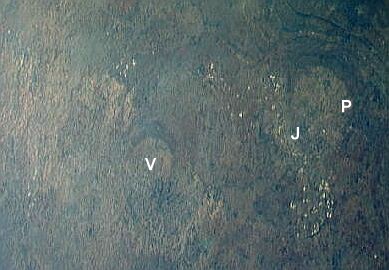
NASA Johnson Space Center (Image STS008-35-1296)
From high altitude these hills bear a strong resemblance to the larger, near-circular ring of hills north-east of Vredefort, whose northern side, the Magaliesberg hills, cuts through Pretoria (letter "P") and whose southern side, the "Witwatersrand" ridge, cuts through Johannesburg (letter "J"). These surround the uplifted area known as the "Johannesburg Dome". The white dots running in a band along the Witwatersrand are not clouds, they are the waste dumps from the gold mines along the south side of the Witwatersrand. West of Johannesburg and due north of Vredefort can be seen the gold mine dumps of Carletonville. The gold mines of Klerksdorp and Welkom lie north-west and south-west of Vredefort, and their dumps are also easily seen. Is this half ring of gold mines around Vredefort a coincidence?
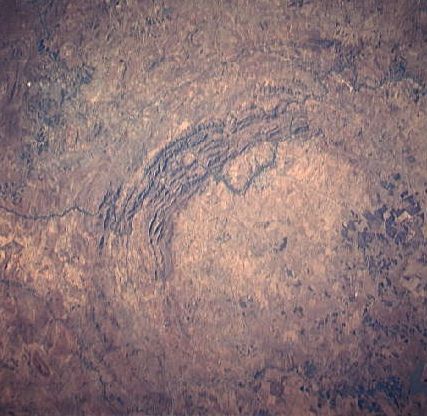
NASA Johnson Space Center (Image STS51I-33-56AA)
Pictured above is a higher resolution view of the Vredefort hills from space. The Vaal river meanders through the hills, flowing from north-east (upper left) to west (centre right). Parys (the Paris of South Africa!) lies on the loop of the river protruding within the ring of hills. Vredefort is close to the geometric center of the hills.
Only the north western half of the structure remains visible. The south eastern half was flooded by the sediments of the Karoo Supergroup, which cover the Free State province.
The same rock layers seen in the Witwatersrand are found in the Vredefort dome hills, but here they are found standing nearly vertically - the result of extreme upliftment.
Evidence has been found by geologists that the cause of this upliftment was an extreme impact event, caused by an asteroid some 10 kilometres in diameter. The ring of hills we see now are the eroded remains of a dome created by the rebound of the rock below the impact site after the asteroid hit. The original crater, now eroded away, is estimated to have been 250 - 300 kilometres in diameter. Some 70 cubic kilometres of rock would have been vaporised in the impact.
The Vredefort structure is currently regarded the biggest and oldest clearly visible impact structure on Earth. It just beats the Sudbury impact structure in Canada for this ranking. The Sudbury structure is some 200 km in diameter and is estimated to be 1.85 billion years old.
Evidence for four impacts even older than than Vredefort, that occurred 3.2 to 3.5 billion years ago, has been found in the greenstone rocks around Barberton in South Africa and corresponding rocks in the eastern Pilbara block of Western Australia. However, these impacts are no longer recognizable as structures on the surface like Vredefort's.
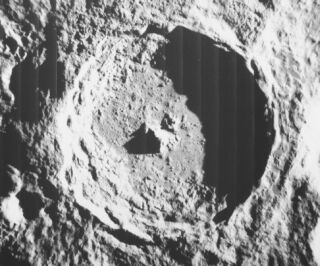
NASA Lunar Orbiter image
The central mountains in the 85 kilometre diameter lunar crater Tycho show what the Vredefort dome is the remains of - the central rebound peak, NOT the crater itself, which at Vredefort has long since eroded away. The erosion processes occuring on Earth are of course missing on the Moon, hence the "as new" appearance of Tycho.
What is the evidence for the impact at Vredefort?
The pictures below tell some of the story.
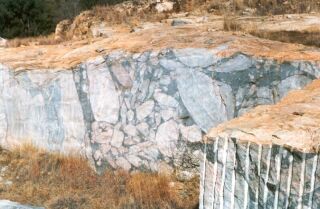
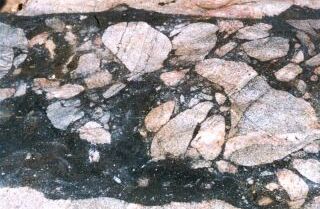
Within the ring of hills at Vredefort is found granitic gneiss rock - as in the Johannesburg Dome - which is dated at some 3200 million years old. Here a quarry at Leeuwkop near Parys reveals one of the indicators of the impact. The image above left shows the cut surface of the rock. The pale and medium greys on the left are the natural colours of the granite. But from the centre to the right edge is a wide dark grey band containing large and small fragments of the granite. This is "pseudotachylitic brecchia" - the dark grey is granite that was melted by the impact and flowed, carrying chunks of unmelted granite within the melt. The vertical face seen here is two to three metres in height.
The image above right is of a nearly horizontal exposure of pseudotachylite at the quarry. The width of the band is about one metre. Similar rock is found at elsewhere, in geological faults where rocks move against each other and melt at the interface, but this produces a melt band that is centimetres rather than metres wide as seen here.
The basement granite exposed within the ring of hills is estimated to have been seven to ten kilometres beneath the surface when the impact occurred, which is dated at 2000 million years ago. The date was established from zircon crystals found in the pseudotachylite and granophyre (below), and, more precisely, is 2023 +- 5 million years. All the covering rock has since been removed by erosion. Later the south-east part was covered by much younger Karroo rock formations.
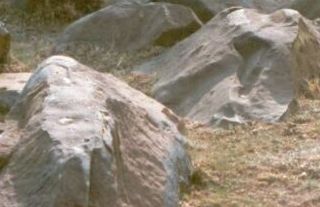
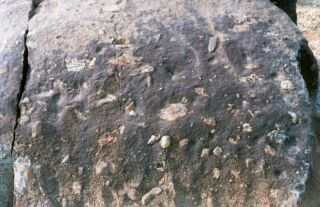
The picture above left shows one of the dykes located close to the centre of the impact, at Daskop. Its width at the surface is about three metres, but it is hundreds of metres long where it is exposed here.
The boulder in the dyke shown above right shows the small, fractured inclusions of unmelted rock that are typically 1 - 3 cm in size. This is much smaller than the rocks embedded in the pseudotachylite at the quarry, which are up to metres in size. The small inclusions may have come from considerable distances - tens of kilometres away.
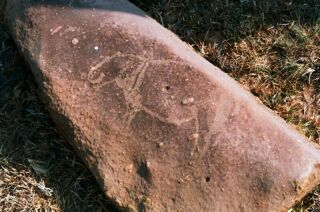
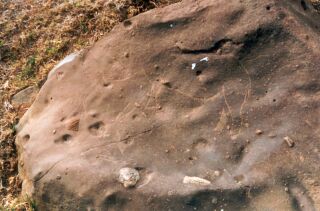
These rocks have also been the target of graffiti artists - in this case San hunters perhaps 2000 years ago. Shown above left is an engraved hippopotamus.
Pictured above right is an equally accurate engraving of a rhinoceros. Less obvious is the eland, the largest antelope, engraved inverted (from this perspective) in front of the rhino. It shows up more clearly in the large version of this image.
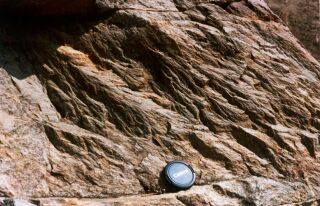
Another signature of an impact is left by the passage of shockwaves through the underlying rock. This produces fractures with a characteristic "fir tree" pattern. In this particularly clear example found next to the Vaal river at Schoemansdrif, the shock wave passed through from upper left to lower right.
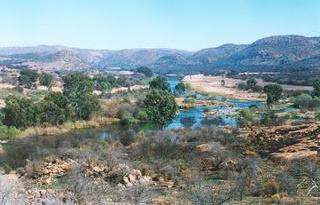
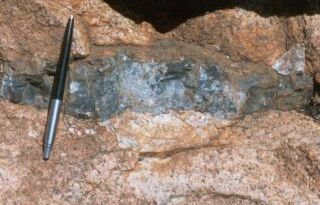
The view above left is a panorama over the Vaal river. It was taken facing west, at Schurwedraai. The next ring of hills forms the horizon.
The rocks at the site where the photograph of the river was taken at Schurwedraai are quite different to the basement granite, but also show dark grey veins of pseudotachylite - melted rock. The pen gives the scale in the picture on the right.
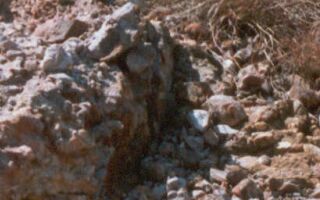
This ring of hills comprises quartz conglomerates as found in the gold-bearing strata of the Witwatersrand reefs. The white quartz pebbles are evident. This was once the bed of a fast flowing water course which deposited grains of quartz and the pebbles. This area was mined for gold in the 1880's. However the concentration of gold was much poorer than at Johannesburg, and the diggings were soon abandoned. Old mine adits are still to be seen in the hills. This is the Amazon Reef.
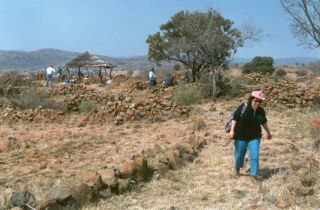
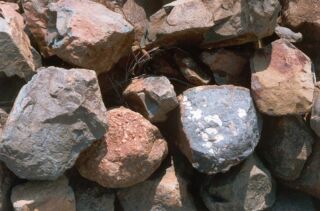
The outermost ring of hills was home to a quite different group of people in the 1500's to 1700's. These were SeSotho/SeTswana-speaking farmers. This village at Askoppies was a defensive position on the crest of the hill, but it did not save the village from destruction, by the warriors of Mzilikazi. The view shown above left looks east, back in towards the inner rings of the Vredefort dome.
The stone walls of the village are shown above right. They are made of the fine-grained grey Ventersdorp lavas that comprise this ridge. These rocks are 2700 million years old.
I'm not sure why this popped up in the Xplanets keyword after so many years, it must have been in there long ago, but anyway, not a good sign. Good time to post updated ping messages for a twofer.
· join · view topics · view or post blog · bookmark · post new topic · subscribe · Google news searches: exoplanet · exosolar · extrasolar ·
The Meteorite That Buried Michigan | The Sudbury Impact
Alexis Dahl
9.12K subscribers
190,740 views
October 1, 2021
https://www.youtube.com/watch?v=ycQexghR61w
https://search.brave.com/search?q=sudbury+crater+youtube&source=desktop
Disclaimer: Opinions posted on Free Republic are those of the individual posters and do not necessarily represent the opinion of Free Republic or its management. All materials posted herein are protected by copyright law and the exemption for fair use of copyrighted works.